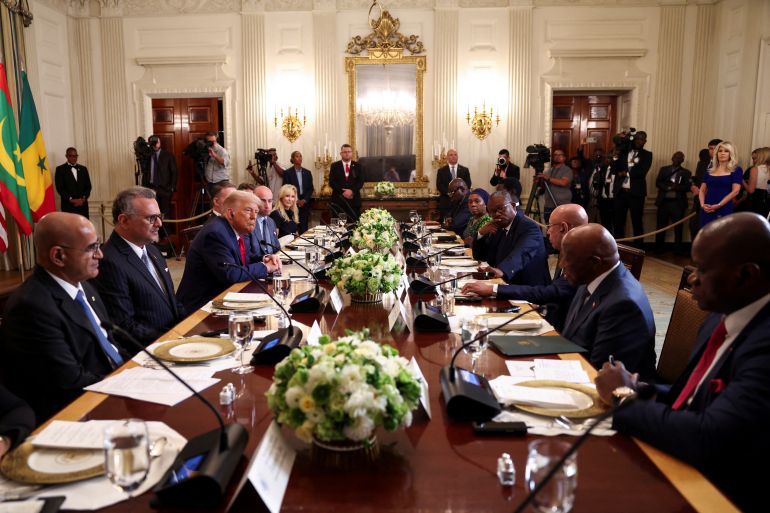By Gerald Mbanda

In early July 2025, President Trump hosted a mini-summit in Washington with the presidents of Gabon, GuineaBissau, Liberia, Mauritania, and Senegal—five coastal West and Central African nations rich in natural resources. This event is seen as an element of Trump’s “America First” strategy, sharply pivoting U.S. Africa policy away from traditional aid and toward trade, investment, and supplychain alignment—with an explicit goal to challenge China’s deepening influence on the continent.
The selectivity of the nations invited to the summit raised questions about why only these five were chosen. First, these countries are resource-rich and offer critical minerals like manganese, iron ore, gold, uranium, oil, and rare earth elements—vital for American industry and strategic supply chains. They are also seen as low-hanging fruit geopolitically, as they are not heavily involved in regional political alliances such as BRICS, making them ideal partners for U.S. economic outreach without the complexity of dealing with larger, more politically influential countries. Additionally, the five nations hold strategic coastal positions, which could help address U.S. concerns over migration flows, maritime security, and the expansion of Chinese and Russian influence in the Gulf of Guinea.
Since Trump’s second term began, his administration has dramatically reduced foreign aid to Africa, scrapping USAID and shifting focus toward investment through the U.S. International Development Finance Corporation (DFC). This shift also coincided with an expansion of global tariffs—targeting up to 14 countries, including key African economies like South Africa—while imposing tariffs on BRICS-aligned nations. The White House’s approach has been transactional, rewarding nations that offer strategic resources or agreements with favorable deals, and penalizing those aligned with perceived adversaries. Critics argue that this strategy undermines African development, as it prioritizes short-term economic benefits over long-term humanitarian needs.
During the summit, the Trump administration emphasized trade over aid, promising that the five nations would avoid the next round of U.S. tariffs. The DFC confirmed a new commitment to financing the Banio Potash Mine in Gabon, as part of a strategy to promote Africa’s economic independence—and U.S. access to critical minerals. Discussions also included peacebuilding linkage: referring to U.S.-brokered mediation in the DRC–Rwanda agreement, with minerals like rare earths seen as diplomatic leverage.
Despite the U.S. focus on trade, voices from Africa raised concerns about the reduction in aid, warning that this could have severe humanitarian consequences, including projections of millions of additional deaths by 2030. African Union officials, in particular, criticized new U.S. tariffs and visa restrictions as abusive.
China’s influence in Africa was a subtext of the summit. Africa has been a significant focal point of China’s Belt and Road foreign investment, infrastructure projects, and tariff exemptions, leading many to see the summit as a strategic counteroffer from the U.S. Analysts noted that the U.S. was offering an alternative to African countries who had leaned into Chinese investments. Washington’s intent appeared to be to push for African nations to align with the U.S., not China, offering trade incentives in exchange. Though Trump didn’t mention China directly during the lunch, the selectivity of the nations invited to the summit was telling. By choosing smaller nations not aligned with China, the U.S. was sending a clear message: align with Washington for economic rewards, or risk the consequences of Chinese influence.
Trump’s outreach to these five African countries signals a sharp reorientation in U.S.–Africa relations, driven primarily by the access to natural resources, trade leverage, and a broader geopolitical rivalry, particularly with China. The choice of invitees, the focus on trade over aid, and the emphasis on resource extraction over diplomatic cooperation all highlighted the administration’s transactional approach. By prioritizing smaller, strategically located countries with valuable resources, the U.S. is clearly seeking to maintain its influence in Africa while limiting China’s growing economic footprint.
This summit represents a key moment in the evolving U.S. approach to Africa, reflecting Trump’s larger foreign policy agenda of transactional relationships. How African leaders respond—balancing the lure of U.S. trade incentives with the growing need for long-term development aid—will shape the future of U.S.–Africa relations. The broader U.S.–Africa summit around the UN General Assembly in September will serve as a key test: can Washington scale this transactional approach into something more comprehensive that resonates across the continent, and able to compete with China’s practical and transformational development cooperation.
The summit with five African leaders demonstrates a redefined U.S. strategy—one focused on extracting resources, pushing for favorable trade agreements, and competing with China’s influence on the continent. However, this approach has drawn concerns about its sustainability and long-term benefits for Africa, especially as many nations continue to rely on external aid for development. How African countries balance the short-term trade deals with the broader need for infrastructure, social development, and humanitarian aid will be critical in determining the trajectory of U.S.–Africa relations in the coming years.
Gerald Mbanda is a Researcher and publisher on China and Africa.
 Africa -China Review Africa -China Cooperation and Transformation
Africa -China Review Africa -China Cooperation and Transformation
